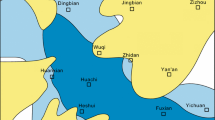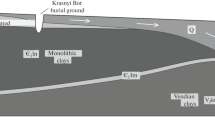Abstract
Long-term water infiltration into porous media, like clastic deposits, causes colmatage (clogging), which is expressed by the decrease of permeability. It is caused by progressive filling of pore spaces with fine particles carried in suspension (mechanical colmatage) and minerals precipitated from water (chemical colmatage or biochemical colmatage, when the process is affected by bacterial activity). Although this material is introduced into the sediment after deposition, it does not destroy the primary framework of it but it only coats grains and fills voids. This process results in some characteristic microstructures that are called ‘clogging microstructures’. The research included: (1) experiments on sands exposed to mechanical colmatage in laboratory conditions, which aimed to describe clogging microstructures and to examine the effects of grain size distribution on the rate and degree of clogging; (2) field and laboratory studies of deposits in which colmatage occurred in natural conditions in the infiltrating water intake ‘Dębina’ in Poznań, Poland. The main goal of the research was to identify post-depositional changes that took place in fluvial deposits affected by forced river water infiltration in the Warta River valley. Examples are presented of clogging microstructures formed in deposits affected by colmatage in the laboratory and in natural conditions.
Résumé
Dans les milieux poreux, comme les dépôts clastiques, l’infiltration d’eau entraîne un colmatage, qui se traduit par une diminution de la perméabilité. Ce phénomène est dus au remplissage progressif des pores du sol avec des particules fines transportées en suspension (colmatage mécanique) et à la précipitation de minéraux (colmatage chimique ou biochimique lorsque des bactéries participent au processus). Bien que ces éléments soient inclus dans le sédiment après son dépôt, ils ne détruisent pas la structure primaire de celui-ci mais ils remplissent les vides et habillent les grains. Ce processus permet la formation de micro structures caractéristiques appelées structures de colmatage. Cette étude inclut: (1) des expériences sur des sables soumis à un colmatage mécanique en laboratoire, ceci afin de décrire les micro structures de colmatage et permet d’étudier les effets de la distribution de la taille des grains sur le taux et l’intensité du colmatage; (2) des études sur le terrain et en laboratoire de dépôts dans lesquels le colmatage intervient dans des conditions naturelles d’infiltrations de ‘Debina’ à Poznan, Pologne. L’objet principal de cette étude est l’identification des changements post-dépôts qui interviennent dans les dépôts fluviaux affectés par l’infiltration forcée d’eau de rivière dans la vallée de la rivière de Warta. Des exemples de microstructure de colmatage formés dans les dépôts affectés par le colmatage en laboratoire et sur le terrain sont présentés.
Resumen
La infiltración de agua a largo plazo en los medios porosos, tales como los depósitos clásticos, causa colmatación (taponamiento), que se expresa por la disminución de permeabilidad. Esta es causada por el relleno progresivo de los espacios entre poros, con partículas finas llevadas en suspensión (colmatación mecánica) y por minerales precipitados a partir del agua (colmatación química o colmatación bioquímica, cuando el proceso es afectado por la actividad bacteriana). Aunque este material se introduce en el sedimento después de la depositación, no destruye el armazón primario de él, solamente cubre los granos y llena los vacíos. Este proceso produce algunas microestructuras características llamadas ‘ microestructuras de taponamiento’. La investigación incluyó: (1) experimentos en arenas expuestas a colmatación mecánica en condiciones de laboratorio, que apuntaron a describir microestructuras de taponamiento y a examinar los efectos de la distribución del tamaño de grano en la rapidez y grado de taponamiento; (2) estudios de campo y laboratorio a depósitos en los cuales sucedió la colmatación en condiciones naturales, en la toma de agua infiltrada ‘Debina’, en Poznan, Polonia. La meta principal de la investigación era identificar cambios post-deposicionales, que tuvieron lugar en los depósitos fluviales afectados por la infiltración forzada de agua de río, en el valle del Río Warta. Se presentan los ejemplos de microestructuras de taponamiento, formadas en depósitos afectados por la colmatación en el laboratorio y en condiciones naturales.














Similar content being viewed by others
Notes
Wacławski (1970) showed that the clogging index η reaches the maximum value in the uppermost layer (0–0.05 m) and decreases with depth.
The effects of the so called ‘outside colmatage’, which results in accumulation of deposits from suspension at the bottom of infiltration ponds, have been omitted here. This membrane is easily removed when the ponds are cleaned twice a year.
Within algal mats, Chlorophyceae were detected (probably Spirogyra – order: Conjugatae, sub-order: Conjugataethat). They are freshwater organisms that may live in the wetlands (Szweykowska and Szweykowski, 1995).
References
Bodziony J, Litwiniszyn J (1962) Mathematical approach to the phenomenon of colmatage of an n-fractional suspension of particles. Biuletyn PAN, t.10, nr 1
Dunn TL (1992) Infiltrated materials in cretaceous volcanogenic sandstones. San Jorge Basin, Argentina. SEPM Special Publication No. 47, pp 159–174
Gray DH, Rex RW (1965) Formation damage in sandstones caused by clay dispersion and migration. Proceedings of the 14th national conference on clay and clays minerals, Pergamon, London, pp 355–366
Herzig JP, Leclerc DM, Legaff P (1970) Flow of suspensions through porous media, application to deep filtration. Ind Eng Chem 62:8–24
Houseknecht DW, Ross LM Jr (1992) Clay minerals in Atokan Deep-Water Sandstone Facies, Arkoma Basin: origins and influence on diagenesis and reservoir quality. SEPM Special Publication No. 47, pp 227–240
Ives KJ (1980) Deep bed filtration: theory and practise. Filtration and separation, 17, March/April 1980, Croydon, England, pp 157–167
Ives KJ (1987) Filtration of clay suspensions through sand. Clay Miner 22:49–61
Jones FO Jr (1964) Influence of chemical composition of water on clay blocking of permeability. J Petrol Tech 16:441–446
Klappa (1980) Rhizoliths in terrestrial carbonates: classification, recognition, genesis and significance. Sedimentology 27:613–629
Kowal AL, Świderska-Bróż M (1997) Oczyszczanie wody (water treatment). Wyd. Nauk. PWN [in Polish]
Małecki JJ (1998) Rola strefy aeracji w kształtowaniu skladu chemicznego płytkich wód podziemnych wybranych środowisk hydrogeochemicznych (Role of the aeration zone in forming chemical composition of shallow ground waters, based on cases of selected hydrochemical environments). Biuletyn PIG, nr 381, Warszawa [in Polish with English summary]
Matlack KS, Houseknecht DW, Applin KR (1989) Emplacement of clay into sand by infiltration. J Sediment Petrol 59(1):77–87
Moraes MAS, De Ros LF (1990) Infiltrated Clays in Fluvial Jurassic Sandstones of Reconcavo Basin, Northeastern Brazil. J Sediment Petrol 60(6):809–819
Moraes MAS, De Ros LF (1992) Depositional, infiltrated and authigenic clays in Fluvial Sandstone of the Jurassic Sergi Formation, Reconcavo Basin, Northeastern Brazil. SEPM Special Publication No. 47, pp 197–208
Potter JM, Dibble WE Jr (1983) Formation damage due to colloid plugging. Society of Petroleum Engineers of AIME, paper 11801, pp 257–262
Skolasińska K (2000) Przeobrażenia osadów doliny rzecznej w warunkach infiltracji wód powierzchniowych na przykładzie poznańskich ujęć wody (post-depositional changes of fluvial deposits caused by infiltration, Poznań water intakes, Poland). Ph.D. thesis, Institute of Geology, Adam Mickiewicz University, Poznań [in Polish]
Skolasińska K (2001) Clogging of sandy deposits by iron compounds under infiltration conditions (Holocene, Warta River Valley, Poznań—water intake). Prace Spec. Pol. Tow. Mineralogicznego, zesz. 18, 189–194
Szweykowska A, Szweykowski J (1995) Botanika (Botany), t. II— Systematyka (Systematics). Wyd. Nauk. PWN, Warszawa [in Polish]
Trzaska A (1965) Wyniki pewnych doświadczeń nad zjawiskiem kolmatacji (Results of some experiments on colmatage). II Sympozjum Filtracji Gdańsk, 12–17 [in Polish]
Wacławski M (1970) Analiza procesu kolmatacji utworów piaszczystych w świetle badań laboratoryjnych (Clogging of sandy deposits in the laboratory). Ph.D. thesis—Archive of Cracow University of Technology [in Polish]
Walker TR (1976) Diagenetic origin of continental red beds. In: Falke H (ed) The continental permian in central, west, and south Europe. D. Reidel , Holland, pp 240–282
Walker TR, Waugh B, Grone AJ (1978) Diagenesis in First-Cycle Desert Alluvium of Cenozoic Age, SW United States and NW Mexico. Geol Soc Am Bull 89:19–32
Wilson MD, Pittman ED (1977) Authigenic clays in sandstone; recognition and influence on reservoir properties and paleoenvironmental analysis. J Sediment Petrol 47:3–31
Żurawski M, Skonieczny J, Kaniecki A (1971) Współczynnik filtracji— zmodyfikowana metoda Kamieńskiego (Hydraulic conductivity— modified formula by Kamieński). Zesz. Nauk. UAM, ser. Geografia, nr 6, Poznań [in Polish with English summary]
Acknowledgements
This article forms a part of the Ph.D. thesis supervised by Jan Przybyłek (Adam Mickiewicz University, Institute of Geology). I would like to thank him for valuable discussions and support in research. I am also grateful to Jurand Wojewoda (Wrocław University, Institute of Geologic Studies) who got me interested in infiltration processes and who supplied unique papers. I also express special appreciation to Joanna Rotnicka (Adam Mickiewicz University, Institute of Geology) for the review of the manuscript and some English corrections. Thorough reviews by Stefan Wohnlich and Peter Wycisk, as well as suggestions made by an anonymous reviewer, greatly improved this article, and I gratefully acknowledge their efforts. I would also like to thank Sue Duncan (Technical Editorial Advisor of Hydrogeology Journal) for editorial support. The research was supported by the Polish Scientific Research Committee (KBN – No. 6 PO4D 01814).
Author information
Authors and Affiliations
Corresponding author
Rights and permissions
About this article
Cite this article
Skolasińska, K. Clogging microstructures in the vadose zone—laboratory and field studies. Hydrogeol J 14, 1005–1017 (2006). https://doi.org/10.1007/s10040-006-0027-2
Received:
Accepted:
Published:
Issue Date:
DOI: https://doi.org/10.1007/s10040-006-0027-2




